|
This review page is supported in part by the sponsor whose ad is displayed above
|
||||||||||||||||||||||||
 |
||||||||||||||||||||||||
| As Nelson Pass had first pointed out to me, the Abby's bass benefits from about a half bag of Polyfill stuffed into its base through the port to add just a touch of damping. This minimizes a certain ringing or hollowness in the lower midband and upper bass generated by what could be organ pipe resonances inside the cabinet. My local Walmart sells Polyfill in the fabric department for less than $4/bag. One bag'll do to remove this minor cellulite. Selecting lower rather than higher Bailey attenuator settings and a low-pass value around 60Hz then has you all set. (The frequency selector of the Bailey starts at 50Hz in the 5:30 position and ends at 100Hz in the 7:30 position, giving amazing flexibility for fine adjustments over a narrow band.) Bumping up this low-pass value can deliberately inject added warmth and each user will season to taste. Taste. The Abby/Bailey combo gives you a very serious taste of the single-driver phenomenon in a decorator-friendly, wallet-happy, placement-flexible package. By general comparison, network-filtered speakers sound - well, filtered. Immediacy and suchness get cut, live vitamins killed for a bit of homogenization and longevity on the shelves. Okay, this simile is bigger than the occasion warrants but you get the drift. Also, most multi-way dynamic speakers need to be goosed before they spread their wings. The Abbys wake up at 4:00AM, way early and quiet enough to let everyone else sleep undisturbed. You can goose them 'til kingdom come but at truly happy levels, they get a bit shouty and sharp, with that 4kHz peak gaining in relative prominence to stand out. But stay within a 12-or-so-feet field from them at non-headbanger levels and you'll remain in their good graces, in the heart of their benign power band before things start to get pushed and sound pushy. The Bailey's Birch Ply cabinet doesn't overdamp the bass to produce dry farts but creates a nice live bloom - well-defined and bouncy, not cyborg brutal as though emanating from a concrete bunker. |
||||||||||||||||||||||||
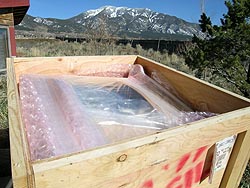 |
||||||||||||||||||||||||
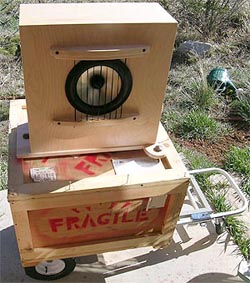 |
||||||||||||||||||||||||
| With his Bailey, Terry Cain wisely didn't opt for superlative SPLs or record-setting infrasonics but speed and precision. The 10" Seas metal-cone driver with the stout phase plug will likely telegraph limitations when asked to participate in the usual search-to-destroy spectacles of he-man subwoofer shootouts (the ones that consider THX-style levels a starting point rather than bleeding-ear insanity). But who cares. When it comes to music, the Bailey is cream. It performs just as intended. It transforms the Abby into an affordable full-range speaker with proper meat in the midbass power zone. As a single-driver device, this would otherwise necessitate some unwieldy horn monstrosity, hardly something you'd drag through the front door to romance your loved ones into audiophilia with. The EL-34 fitted M520 in pentode mode is a bona fide tone champ but into the Abbys ultimately suffered either insufficient damping factor by way of a highish output impedance or just an overall voicing that erred on the loose and slightly fuzzy side. Though feedback can be increased -- with the former assumption predicting that more would be better -- less in this instance simply sounded better, being all about tone and romance and less about precision and articulation. On a different note, the Abby's treble attenuates noticeably off-axis. In other words, standing up turns the treble control counter clockwise. Toe-in will depend on inter-speaker and listening distance but firing straight ahead will likely diminish treble unless you sit excessively far away. Where Terry mounts his driver inside the wooden disc on the sloping baffle strategically matches the average listening height. Nothing needs to be done for serious listening except to sit ye down. |
||||||||||||||||||||||||
Once you do, you'll get your first glimmer of timing and that pungent quality of P.R.A.T. which our British friends coined to distinguish their sensibilities from our Yankee obsessions with B.R.A.T. (insert whatever you will but "B" surely must stand for Bigger is Better Bass). The soundstaging over the Abbys is very deep and precisely placed within the edges defined by the speaker cabinets. The Fostex driver doesn't quite exhibit the spectacular luv for vocals a well-implemented Lowther DX-55 gives off but compared to most conventional dynamic drivers, it's far ahead of the game and mimics triode presentations for its sense of one-on-one intimacy. On Paco Ortega's soundtrack to Albacete & Menkes' movie Sobreviviré, Alba Molina sings a sevillanas accompanied simply by José Antonio Rodriguez on guitar. Singing with her heart in her throat, the Abby unravels the most minute changes in sound pressure, conveying the heaviness of her emotions, the emphatic peaks where she bares her blade, the intermediate hesitations during which the voice gets hooded and thick. No instrument is as multi-faceted as the human voice and the Abby let's you know this. Adding a bit of energy which isn't exactly factual, it's nonetheless in the service of communicativeness, probably less objectionable so because HF output of this driver begins to gradually attenuate at 8kHz and is down 5dB at 20kHz. The only drawback really is an emphasis of certain sibilants. |
||||||||||||||||||||||||
 |
||||||||||||||||||||||||
|
Yours truly for scale
|
||||||||||||||||||||||||
| While conventional $1,500/pr speakers will do certain things better especially in the upper-most treble (which is why the Super Abby adds an adjustable rear-firing tweeter), the Abbys rule when it comes to conveying the life and energy encoded in the music. Direct-heated single-ended triodes, direct-coupled single-ended transducers - the parallels are obvious. So are the reasons why combining the two is popular. They conform to the expectations and priorities of a particular kind of listener. He is more forgiving of deviations from measured perfection but far less so when it comes to conviction and participatory involvement. She will innocently ask who needs level-flat if it sounds so boring? By the time you add the 10" Seas Excel W26FX001 to the recipe, the Abby gains solid grounding and true bass to eliminate the Achilles' heel of the single-driver genre - a tipped-up tonal balance without foundation. | ||||||||||||||||||||||||
 |
||||||||||||||||||||||||
 |
||||||||||||||||||||||||
 |
||||||||||||||||||||||||
| The presence of the sub anchors the upper midrange energy with solid bass weight to render it more of a spice than a detracting intrusion or annoyance. It also means you can play things louder before the prominence becomes too obvious. It also means that Trance, Ambient, Electronica and large-scale symphonica -- such as has been expertly | ||||||||||||||||||||||||
| compiled on AAD's wonderful hybrid SACD sampler The Symphonic Sound Stage [TM-SACD9004.2] -- are all fair game. Dainty SET limitations of string quartets are demolished. This is doubly true because even underendowed triode amps won't have a problem driving the Abbys. The self-powered 300-watt solid-state Bailey then kicks in where the triode amps usually lose their lunch. In many respects, this combination really gets you the best of two worlds, scaled back merely in terms of ultimate refinement and grandiose scope. |
||||||||||||||||||||||||
| You could spend a lot more money and not get the vibrancy, color, speed and sheer fun factor of the Abby/Bailey rig. I'd rather trade a few degrees of refinement for a bit of occasional rawness if this opens the flood gates of musical energy transmission. In many ways then, these Cain & Cain devices perform well beyond their price point. I'd wager a guess that Terry sells far more Abbys than anything else - not just because they're his most affordable model but because they deliver that live charge and excitement already in such full measure that paying a lot more for a far larger box with still only a single driver might simply become a less obvious bargain. |
||||||||||||||||||||||||
 |
||||||||||||||||||||||||
| The Onix/Melody SP3 integrated (ca. $550 when you factor that for $1,199, AV123.com sells it together with their Onix Ref1 speakers) turned out to be far quieter than the M520 and truly astonishing not merely in that regard. The sound became a lot more precise and firm but lost a skoch of warmth and that bluesy color the EL34s injected. Transient were more defined, the rhythmic fabric tauter and truly p.r.a.t.ty now. In Chip Stern's immortal scheme of aural characterizations, the M520 was comfort food or red wine, the Onix a dish served in a more upscale eatery or as a more sophisticated white wine - slightly drier, distinctly more sprightly. Resolution too went up especially towards the rear of the stage and in overall control. Whoa Nelly - this really was something to write home about. I also got a few more clicks of usable range out of the SP3's stepped resistor-ladder attenuator than the fast-acting Eastern Electric wiper. | ||||||||||||||||||||||||
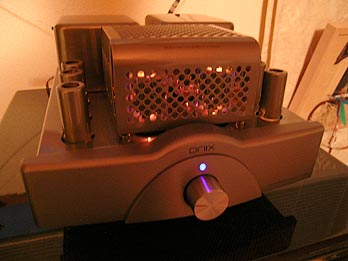 |
||||||||||||||||||||||||
By comparison, the Mullard-inspired circuit was softer around the edges, slightly woolly in fact, with an emphasis on tone, wetness and liquidity. The Melody-designed circuit proved more accurate and precise, a little less luscious (and without remote) but performance-wise in a different league. The upcoming feature review of the Onix integrated naturally will explore its performance into different speakers in appropriate detail. Still, I'm deeply suspicious that I might have stumbled across a giant killer here - and definitively into a load as copasetic as these Abbys. This combination simply turned out to be ridiculously, shit-eating-grin compelling. The Onix even sublimated (though not outright eliminated) those occasional glitters of metal during female vocal peaks and violin passages. If I were to guess, I'd say the Onix has a lower output impedance and hence more control over the driver - and/or the overall implementation simply favors a different presentation. Regardless, the half-priced integrated walked away the clear victor here, reminding us once again that little of true usefulness can be predicted from paper specs alone. Time to insert the 8wpc MiniMax amp into the equation. |
||||||||||||||||||||||||
| Its 8wpc 6BH8s' noise floor was higher than the Melody's 38wpc 5881s but lower than the M520. Like the SP3, it didn't exhibit the 2nd-order octave-doubled tone of the EL34 amp's limpid indulgence. Its aroma of tauter control and more timing-centered accuracy was far more similar to the SP3 though not quite as developed in instrumental timbres. This was a far closer call but the Onix piece retained this listener's final favors. More important than personal preferences here is the plain assurance that this push/pull 8-watter was plenty potent enough to rock down the house. Prospective Abby owners needn't be concerned over mondo or even medium power. In this case, copasetic quality is the only issue and even flea-powered micro-power hunks should be considered. I'd also include medium stature solid statesmen like the 47Labs Shigaraki and Audio Zone chip amps. On the subject of transistors, no single-driver speaker discussion would be complete without Admiral Nelson's FirstWatt F1, however. |
||||||||||||||||||||||||
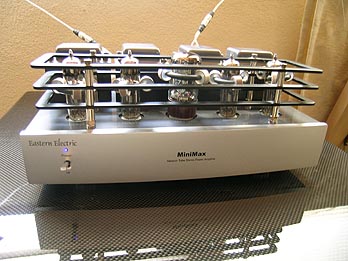 |
||||||||||||||||||||||||
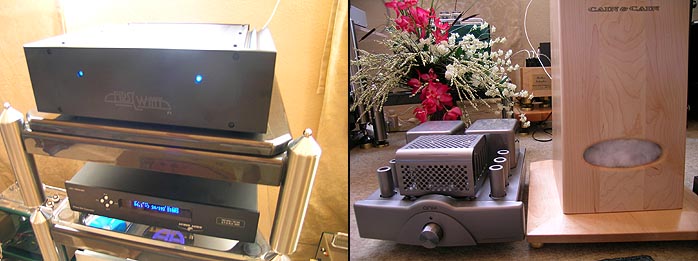 |
||||||||||||||||||||||||
It doesn't have a noise floor, being quite possibly the quietest amp presently on the market. Into the Abbys, it exhibited the best control and dynamics while also introducing a benefit of release/acceleration very similar to the just-reviewed Walker Audio Velocitor S. Without tube-flavored THD artifacts, you have to source these from elsewhere if you fancy them. The Eastern Electric MiniMax is a perfect and perfectly affordable solution in this context. I used the Audio Aero Prima SE tube DAC/preamp direct and was perfectly content. However, the ultimate combo I could put together from what I had on hand was the MiniMax/F1 combination, running the Bailey via interconnect rather than speaker cable. |
||||||||||||||||||||||||
| Without diminishing the FirstWatt's speed, articulation and phenomenal transparency, the tube preamp simply enhanced harmonic saturation for some of the tonal color valve hounds like yours truly thrive on. Being a hi-gain device, it also introduced some noise to the outer-space vacuum of the F1 but not nearly as objectionably so as the M520. The Bailey's transient definition seemed to marginally improve by avoiding its Z-coupler which allows the internal amplifier to accept an already fully amplified signal from another power amp. As an integrated amp user without preamp output, I wouldn't at all sweat this but if you have a pre-out handy or can Y out from a separate pre/power combo, you should experiment. You'll probably prefer the low-level Bailey connection. If you get the impression that I had fun exploring various sonic flavors with these speakers, you're right. I felt like a chef let loose in a fully stocked kitchen. | ||||||||||||||||||||||||
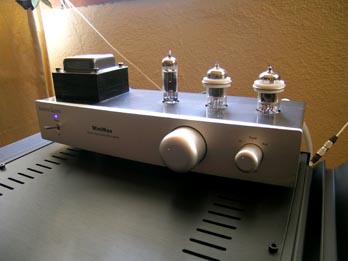 |
||||||||||||||||||||||||
As any resolving device should, the Abbys despite their entry-level price are fully responsive to amplifier flavors and will benefit from some care identifying the perfect mate. This needn't be costly. Mark Schifter's $999 Onix/Melody SP3 should be at the top of your list if your system doesn't exceed two sources and remote control isn't an issue. If your budget can stretch farther, the F1 with an affordable tube preamp like the MiniMax would be at the top of my list. Unless your room is small and you listen predominantly to smaller-scale acoustic fare, you should aspire to adding the Bailey to the Abbys but the appealing aspect about this is that you can do so in stages. Though I've only heard the bigger Cain & Cain models at shows and in Josh Stippich's digs, I consider Terry's Abby his perfect bull's eye product. Its full-range driver approach doesn't attempt to wring more from the driver than it wants to with a simple yet well-executed cabinet. Its easy load behavior places no undue burden on the partnering equipment to keep total system cost well within reason and complexity to a minimum. The Bailey acknowledges the inherent limitations of the Abbys and provides an upgrade path that's fully consistent with the general design philosophy. For $3,000, you end up with esoteric maintenance-free audio that makes a very powerful argument in favor of forgoing ever-elusive dreams about dedicated, fully tricked-out sound rooms filled with exotic trophy HiFi. You can get more refinement and higher SPLs but you won't really get any more musical essence. That's why I'm bestowing our Blue Moon Award on this combo. It's something Listener magazine would have loved and Harvey Rosenberg would have endorsed. In what it does right, it embarrasses many far more hifalutin speakers and dishes out dynamics that usually would require horns. Where it errs, it does so in a manner that will primarily get minor marks in audiophile black books. Most music lovers will be completely oblivious to them since they don't intrude on their grooving in the zone. Call the Abby/Bailey trio Real-Fi or Family-Fi - it's a return to the heart of the hobby as well as a return to sanity and practicality. |
||||||||||||||||||||||||
 |
||||||||||||||||||||||||
| Terry Cain comments:
Srajan, |
||||||||||||||||||||||||
|
|
||||||||||||||||||||||||
 |
||||||||||||||||||||||||
 |
||||||||||||||||||||||||
|
Manufacturer's website
|
||||||||||||||||||||||||
 |
||||||||||||||||||||||||